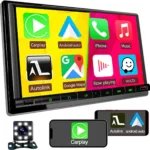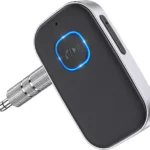The best receiver with AUX input enhances the capabilities of your listening experience in new and exciting ways. On mobile devices, several music providers are transitioning to subscription-based business models. However, your phone most likely does not include a headphone port that can be plugged into your car radio or your home stereo. Both of these audio systems certainly have a greater sound quality than the speaker on your phone. Therefore, a high-quality receiver with AUX input may transform your existing music subscription into a limitless music library for your high-end home entertainment system.

A receiver with AUX input is, all things considered, a relatively inexpensive purchase that paves the way for a vast array of opportunities. Audio codecs, range, and output type are three important characteristics of a Bluetooth audio receiver that you should check for. The discovery of AUX is particularly exciting since it carries with it a remarkable range and very high-quality audio codecs. If you want to use the receiver in your car or with your radio, you should check to see that any receiver you choose has an accurate output that can be connected to those devices. Read on to learn our recommendations in light of all of this information!
- Bluetooth vs. Auxiliary Input in Terms of Sound Quality
- What do AUX and other inputs, together with other connections, mean for an amplifier?
- Which wire should be applied when connecting a record player to a sound system?
Bluetooth vs. Auxiliary Input in Terms of Sound Quality
There is nothing that can compare to the feeling of putting on a set of headphones, turning on the stereo, and listening to some of your favorite playlists or high-fidelity music while you are cooking dinner for a group of friends. However, to have the best sound, what kind of set-up is considered to be the most effective?
When compared to Bluetooth, a receiver with AUX input sound generally has the capability of making a noise of a higher quality than Bluetooth AUX input does. This leads to something that is known as a loss of fidelity, which describes how accurately a copy reproduces its original source material.
Despite the fact that the majority of people aren’t typically able to detect this deteriorating quality, audiophiles might notice it immediately away. Listening to music on AUX devices, which are completely analog from beginning to end, is typically the preference of individuals who are passionate about sound quality. It keeps a high fidelity, which indicates that the quality is extremely close to that of the audio when it was first recorded.
The synchronization of the audio is still another important consideration. As a result of the substantial amount of data translation that is necessary for Bluetooth AUX input to function properly, there is typically a lag in the transmission of data from one device to another. It’s possible that you won’t notice this when you’re listening to music, but if you’re watching a movie or TV show and a character’s lips don’t move in time with their voice, it may be very frustrating. This issue is not present in the virtually immediate signal that is generated by the aux input.
Make sure that your Bluetooth device utilizes low-latency audio coding so that you can reduce the amount of delay you experience. This will also result in an extraordinarily seamless audio-visual experience.
In conclusion, it is important to point out that due to the fact that the receiver with AUX input requires a physical cable, said cables will eventually become worn out. There is a possibility that the sound quality will suffer if the cable sustains damage such as tearing or ripping as a result of regular use. Because Bluetooth doesn’t use cables, you won’t ever have to be concerned about the audio quality deteriorating as a result of using it multiple times.
What do AUX and other inputs, together with other connections, mean for an amplifier?
The technology behind the home theater and high-fidelity audio is no longer as difficult to understand for novices as it was 20 or 30 years ago. Above all else, the proliferation of user-friendly digital technology has made many things simpler; nonetheless, it may still be fairly difficult to figure out the back of an amplifier, AV receiver, or compact system. In most cases, you will locate multiple connection points there; however, the function served by each one might not be immediately clear to all individuals. However, once you have a working knowledge of some fundamental concepts and are able to differentiate between a few distinct types of cable, the process starts to get simpler.
Which wire should be applied when connecting a record player to a sound system?
Generally speaking, connecting record players is a more difficult process. Although it is possible to connect them to the amplifier without using any specialized cables, the question remains as to whether or not this will actually be successful. Users of current amplifiers will typically only be able to hear a few faint noises if any at all because the signal from the device is frequently too weak. The answer is a device known as a pre-amplifier. You have the option of building this into the amplifier or incorporating it directly into the record player. There shouldn’t be any issues using an amplifier that has a receiver with an AUX input connector, even if the pre-amplifier is housed within the record player itself. When it is installed in the amplifier, in addition to the AUX input connector, there is also what is known as a phono input. This is the port through which record players that do not have integrated pre-amplifiers should connect.



